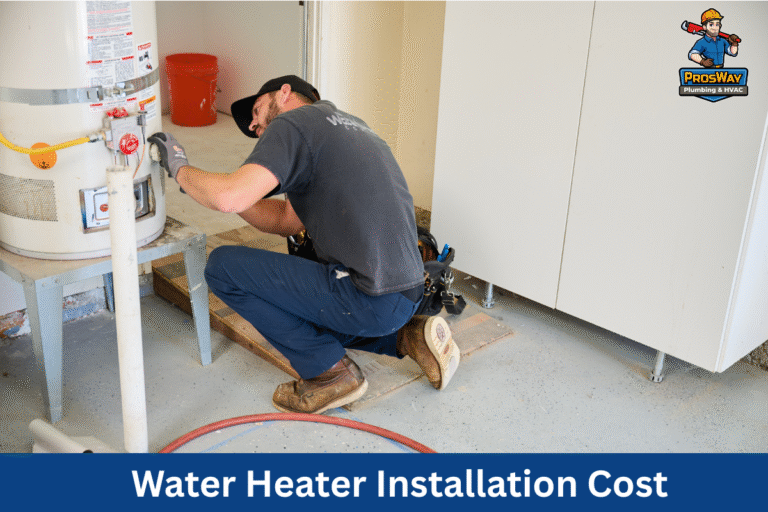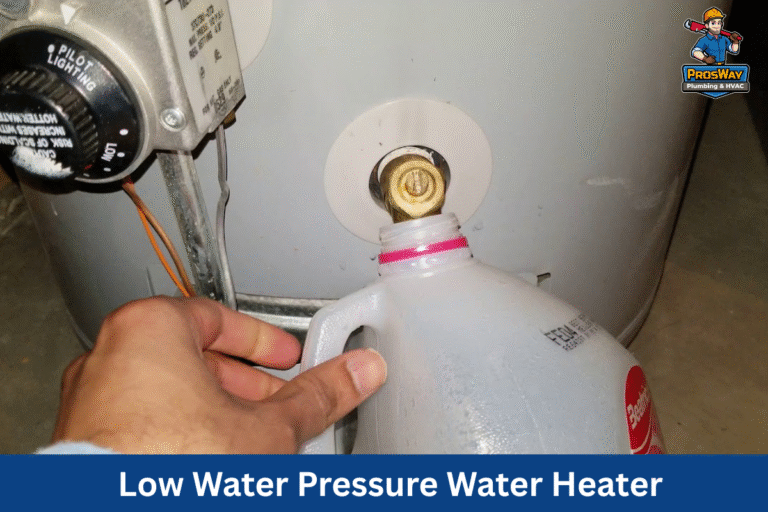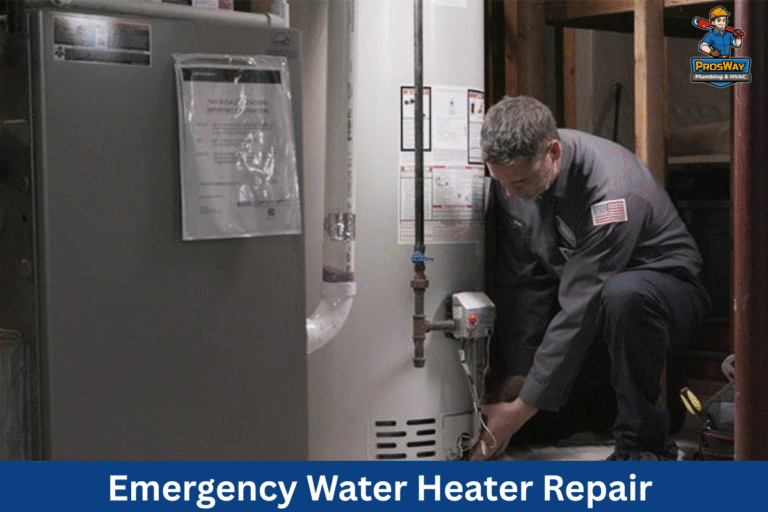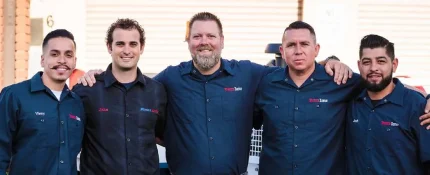After a sewer line replacement, your job as a homeowner isn’t over; it’s just beginning. At ProsWay Plumbing & HVAC, we help Northern New Jersey residents protect their plumbing investments through proper post-installation care.
Whether your project involved trenchless pipe bursting or traditional excavation, maintaining your post-replacement sewer system is critical for avoiding future clogs, leaks, or structural damage. This guide outlines immediate maintenance steps and long-term prevention strategies. You’ll learn to support proper pipe curing and limit early water stress.
Key Takeaways:
- Proper care of a post-replacement sewer line starts immediately after installation and is essential for long-term performance.
- Limiting water usage during the curing period helps prevent early stress and damage.
- Responsible waste disposal and daily maintenance habits reduce the risk of clogs and backups.
- Landscaping choices and water drainage patterns play a significant role in protecting underground sewer lines.
- Regular professional inspections, cleaning, and early response to warning signs ensure system longevity and protect your investment.
What Should You Know About Your New Sewer Line?
Your new sewer line uses advanced materials and sewer line repair techniques such as cured-in-place and trenchless technology. It replaces outdated cast iron pipes and traditional sewer lines.
With modern, durable alternatives that resist leaks and pressure changes. We explain how to familiarise yourself with the new pipe materials, understand the precise location of your sewer line.
And cleanouts, review your replacement warranty and service agreements, and recognise normal post-replacement settling sounds.
Familiarize Yourself With the New Pipe Materials
It is essential to recognize the materials used in your Sewer Line Replacement. Typically, these include reinforced polyvinyl chloride or cured-in-place pipe (CIPP) systems.
These materials offer longevity and resistance to environmental factors like soil acidity and heavy foot traffic on sidewalks. Learning about these advanced materials helps you know what to expect regarding maintenance.
Manufacturers often design these pipes to withstand extensive use and resist cracks that lead to leaks. Moreover, understanding the properties of these pipes can guide you when you need to communicate with service providers.
Where Are the Sewer Line and Cleanouts Located?
Locating your sewer line and its cleanout points is fundamental to maintaining the system. Your cleanouts are typically positioned at accessible areas, allowing for routine cleaning.
Knowing these points enables you to schedule preventive inspections and avoid unnecessary digging. Use maps provided by your installer or contact your plumbing service for detailed layouts.
This practice ensures you can quickly locate the cleanouts in case of a blockage or leak, preventing extensive damage or costly emergency repairs.
Why Is Your Warranty Information Important?
Before signing off on your project, review the warranty details and service agreements provided by the contractor. Warranties may cover materials and labour for a specific period, including emergency repairs.
It is vital to know what is covered, as this can influence your maintenance decisions and help you avoid additional costs. Understanding warranty terms also informs you when it may be time to schedule professional inspections.
What Should You Do Right After Sewer Line Replacement?

Immediately after a sewer line replacement, specific maintenance practices must be followed to guarantee a smooth transition from installation to regular use.
This period is critical because the new pipe requires proper curing, and the soil around it must settle adequately. We will outline the essential post-replacement practices that include allowing adequate curing time.
Limiting heavy water usage, inspecting the work area for settlement issues, and confirming that all drains and toilets are functioning correctly.
Allow Proper Curing Time for New Pipe Materials
The curing process for new sewer line materials, such as cured-in-place pipe systems, is essential. During this period, the pipe material stabilizes and bonds to the surrounding structures, ensuring long-term durability.
Typically, you should wait for the recommended curing time provided by your contractor—often 48 to 72 hours—before subjecting the line to normal water flow. Avoid using appliances that generate high volumes of water.
Such as dishwashers or washing machines, which can introduce excessive pressure. This waiting period helps secure the pipe’s structural integrity and reduces the risk of early damage.
Limit Heavy Water Usage Initially
After installation, it is advisable to reduce heavy water usage for a short period, typically one week to ten days. This restriction minimises pressure fluctuations in the new system until the materials are fully cured.
Avoid long showers, excessive laundry loads, and other water-intensive activities. This precautionary measure prevents the new pipe from being subjected to undue stress, which can compromise its sealing.
Instead, spread your water usage evenly over the day to ensure that no single event causes a surge in water pressure. These initial steps are crucial for safeguarding against unexpected drainage issues during the critical curing.
Where Should You Check for Settlement Issues?
Inspecting the work area after the sewer line replacement is essential. Look for signs of ground settlement near the pipe route, such as small depressions in the yard or uneven pavement.
Ground settlement may indicate compaction in the backfill material or minor imperfections that need attention. Additionally, monitor nearby landscaping and structures for any irregularities.
Early detection of minor settlement issues helps determine whether professional follow-up is required. Performing routine checks during the first few days post-replacement ensures that potential problems are addressed before they escalate into more serious complications.
What Daily Habits Protect Your Sewer Line Long-Term?
Adopting good daily habits is essential for maintaining the longevity of your new sewer line. With a focus on proper waste management and careful habits, you can significantly extend the life of your sewer line.
This section details the daily practices residential property owners need, such as proper disposal of grease and food scraps, and responsible toilet use.
Avoiding non-flushable items, using drain strainers, and refraining from pouring harsh chemicals down the drain.
Dispose of Grease and Food Scraps Properly
One of the simplest yet most effective daily habits in sewer line care is the proper disposal of grease and food scraps. Grease should never be poured down the drain.
It can harden and accumulate inside pipes, leading to blockages and an increased risk of sewer backups. Instead, save grease in a container and dispose of it in the trash.
Additionally, food scraps should be composted or thrown away rather than washed down the drain, as these materials can cause clogs over time.
This habit protects your sewer line and helps maintain overall plumbing health. By following these practices, you can reduce the need for frequent sewer-line-repair calls and save on replacement costs in the future.
What Should You Flush—and What Shouldn’t You?
To maintain efficient sewer flow, flush only human waste and the appropriate type of toilet paper. Avoid flushing items such as wipes, feminine hygiene products, cotton swabs, or extraneous objects.
Even products marketed as “flushable” can gather and cause blockages in the sewer line. By ensuring that only approved materials are flushed, you help preserve the interior of your pipe.
This simple practice is essential for avoiding costly drilling or trenchless repair services when clogs occur.
Watch this video: 13 Things You Shouldn’t Dump Down the Drain.
Avoid Flushing Wipes and Feminine Hygiene Products
Expanding on proper toilet use and avoiding flushing items not designed to break down in water are critical. Regardless of claims on their packaging, many wipes do not disintegrate as effectively as toilet paper.
Feminine hygiene products accumulate in the pipes, contributing to backups and expensive repair jobs. Educate all household members about these risks to ensure consistent application of these habits.
Your commitment to responsible disposal can significantly influence the overall efficiency of your sanitary sewer and central sewer line systems.
What Maintenance Keeps Your Sewer Line Performing Long-Term?
Implementing proactive maintenance strategies can significantly prolong the life of your new sewer line. Regular and professional sewer line checkups are critical once the initial curing and installation period is complete.
This section will discuss several proactive actions, such as scheduling professional inspections, routine cleaning, and managing tree root growth.
Considering a backwater prevention valve, and closely monitoring water pressure. These strategies are designed to catch issues early before they escalate into costly repairs.
Implement Routine Sewer Line Cleaning
Routine cleaning of your sewer line is another proactive measure that helps maintain its performance. Over time, debris and minor buildups can collect in the pipes even with proper daily habits.
Investing in a professional cleaning service every one to two years reduces the risk of blockage and helps maintain precise, unobstructed flow. Professionals use high-pressure water jets or mechanical augers to clear scale.
Moreover, these cleaning sessions provide an opportunity for a professional evaluation of any emerging issues, ensuring that your investment in the new sewer system continues to function for many years.
Manage Tree Root Growth Near Your Sewer Line
Trees benefit landscaping, but their roots can challenge sewer line integrity. Root intrusion is a common cause of sewer line blockages and wastewater infiltration.
Regular monitoring and trimming of trees near your sewer line can help reduce potential damage. Professional root barriers might sometimes be necessary to prevent roots from entering the pipes.
Managing tree roots effectively will help avoid costly pipe-bursting repairs and additional trench digging. This proactive strategy protects your sewer infrastructure from natural stressors while preserving the aesthetics of your property.
When Should You Check Water Pressure?
Consistent water pressure is key to the efficient operation of a sewer system. Fluctuations in water pressure can indicate potential blockages or leaks, and may stress the new pipe materials beyond their capacity.
Regularly monitoring water pressure can help you detect anomalies early. Use a pressure gauge or smart home monitoring system to keep track of any significant changes.
Prompt investigation of these variations can prevent long-term damage and support a smoother operation. This proactive approach, combined with routine inspections, contributes significantly to the extended lifespan of your sewer line system.
Key Takeaways
- Regular professional inspections are essential to catch early-stage problems.
- Routine cleaning prevents buildup that could lead to blockages.
- Managing tree roots near the sewer line protects against intrusion.
- A backwater prevention valve shields your home from potential backups.
- Monitoring water pressure helps identify issues before they worsen.
What Future Problems Should You Watch For in Your Sewer Line?

Even with the best post-replacement care, future issues may arise. Proactively addressing these concerns will save you time, money, and stress.
Let’s discuss common indicators of sewer problems, explain when to call a professional, and advise promptly addressing minor leaks or slow drains.
These steps are essential for ensuring that your replacement sewer line continues functioning efficiently over its long lifespan.
When Do Sewer Problems Start to Show?
Symptoms such as slow-draining fixtures, frequent clogs, foul odours, gurgling sounds, and unexpected changes in water pressure are early indicators that something may be wrong.
If you notice any of these signs, it is essential to investigate immediately. Early intervention can mean the difference between a minor blockage and a primary sewer backup that requires costly repairs.
Why Should You Call a Professional Right Away?
While minor issues might be manageable through daily practices, specific problems require professional attention.
If you spot symptoms like persistent slow drains, continual foul odours, or sudden changes in water pressure, it is time to call a sewer expert. Professionals have the tools and experience to diagnose problems quickly.
Contacting a trusted service like ProsWay Plumbing & HVAC in Northern New Jersey can provide you with expert advice and immediate corrective action. Timely professional intervention fixes the problem swiftly and reduces the risk of future incidents.
Address Minor Leaks or Slow Drains Promptly
Even minor leaks or slow drains should not be ignored. Minor issues can develop into larger problems over time if not addressed quickly.
If you notice a minor leak or consistently slow draining in one part of your home, promptly call a professional for an inspection. Early repairs are typically less costly and disruptive than prolonged delays that may lead to complete system failure.
As part of your regular maintenance routine, address any unusual observations immediately to secure the durability of your sewer line replacement.
Frequently Asked Questions
What causes sewer line blockages after replacement?
Blockages can occur from improper flushing of non-degradable items, grease buildup, or slight root intrusions. Regular cleaning and responsible disposal habits are key to minimising these issues.
Why is it important to restrict heavy water usage after replacement?
Restricting heavy water usage gives the new piping system time to fully cure and settle, which prevents excessive pressure that could compromise the integrity of the installation. This precaution reduces the risk of leaks and blockages.
When should I call a professional for sewer line concerns?
If you notice persistent slow drains, unusual sounds, foul odours, or significant changes in water pressure, it is advisable to call a professional. Early intervention can prevent minor issues from escalating into major repairs.
Can landscaping affect my new sewer line?
Insufficient landscaping can lead to root intrusion and water pooling near the sewer line. Choosing plants with non-invasive roots, proper soil grading, and waiting for the soil to settle are essential for protecting your new sewer line repair installation.
Conclusion
Maintaining your sewer line after replacement is a multi-step process that requires both immediate care and the implementation of daily habits. Every step is key, from understanding your new sewer line system and following post-replacement maintenance practices to adopting long-term habits and proactive strategies. Such diligent care extends the pipe’s service life and minimises future emergency repairs and replacement costs. Remember, consistent maintenance and professional guidance, especially from trusted local experts, ensure your investment remains secure.
Why Wait to Protect Your New Sewer Line? Call ProsWay
Your post-replacement sewer system deserves long-term protection. At ProsWay Plumbing & HVAC, we offer expert maintenance, inspections, and support to keep your investment running smoothly year after year. Call us now at (862) 260-5870 or Book Online to book a post-installation checkup.









